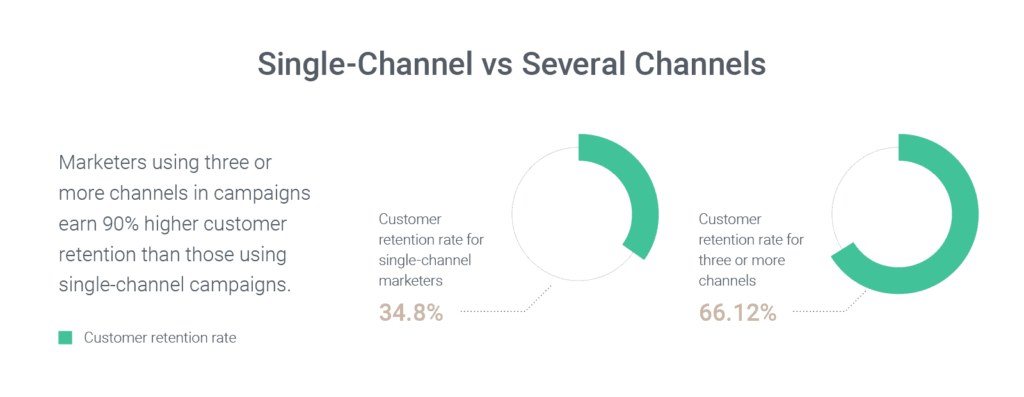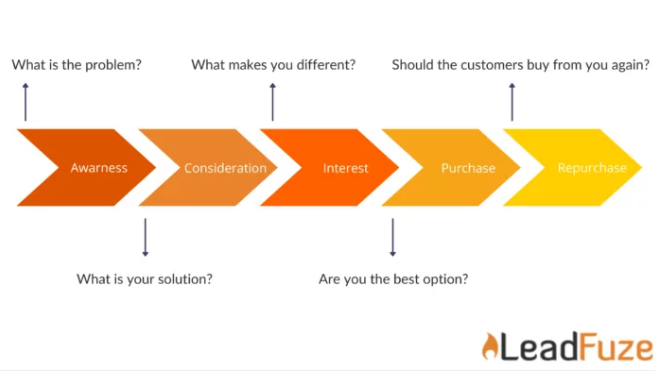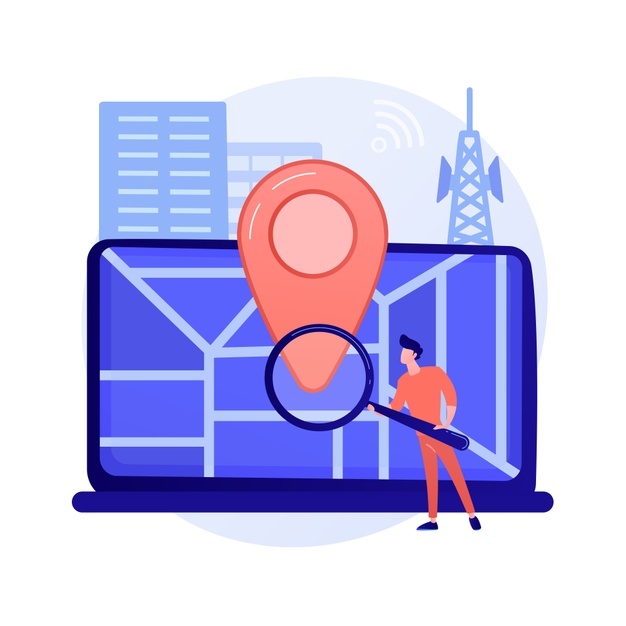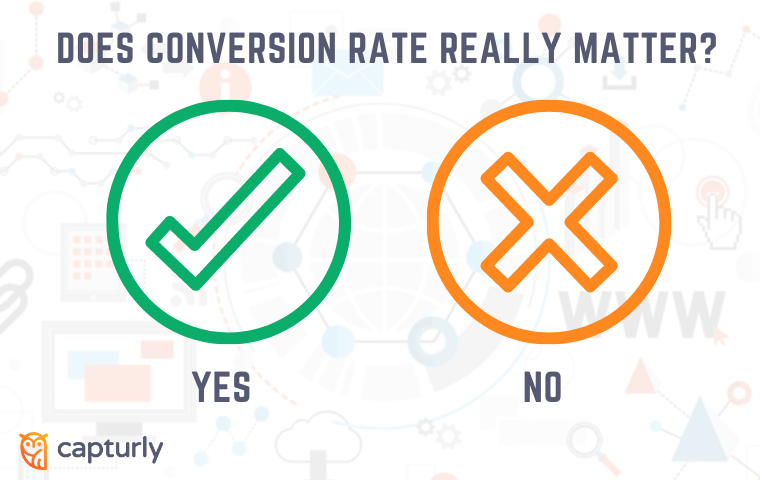Conversion rate is a statistic to determine how many visitors or prospects turn into paying customers or leads for a business.
It’s one of the most important numbers for businesses today, and chances are you’ve been tasked with sending visitors down your conversion funnel.
With email, blog, and online ad campaigns becoming more competitive every day, the importance of conversion rate is at an all-time high. All marketers are trying to figure out how to increase it.
Conversion rate matters because it’s the main way to measure campaign success. After all, if your ads are very successful in turning visitors into customers but are costing you a lot of money to do. So, then the cost of acquiring that customer will outweigh profitability on customer acquisition.
Every time you launch a marketing campaign, you have the goal of achieving the conversion rate. And the dreadful task of ‘making it happen’ hovers over your head!
The conversion rate metric serves primarily as a precursory measure of the effectiveness of an advertisement.
It signifies how many people who are served an ad are motivated to take some sort of action — either by providing their contact information or otherwise making a purchase decision.
Conversion rates depend on several different factors: the offer, the audience it is being shown to, and any other external forces that might influence someone’s decision-making process.
The question remains: does conversion rate matter? In this article, we’ll dig deep into determining whether or not it should be targeted as a primary goal, or left as simply one performance statistic among many.
Table of Contents
How Is A Conversion Rate Calculated?
Let’s say you define conversion as: people who buy the black chair from my website post landing on the site after being served a Facebook ad for the same.
If your Facebook ad motivates 1000 people to visit your website in one month and 100 end up buying the black chair:
The conversion rate for your Facebook Ad campaigns is 100/1000 = 10%.
Isn’t it pretty easy to calculate?
Why Does Conversion Rate Matter?
Conversion Rate matters because higher conversion rates offer greater opportunities for increased revenue. Higher conversion rates also provide more insights into your customers — what, when, and how often they shop, for how long at a time, etc.
Despite all the best aspects of your website, a high conversion rate does matter!
Visitors want to find what they are looking for as easily as possible.
If you build a website but don’t optimize it, there is a chance that conversion is going to fall and marketing efforts will have less and less effect on your business.
Remember that every component of your business needs to work in a unified format or else, the loose ends are going to make your business bleed investment dollars.
Conversion Rate is often misinterpreted as some kind of power ranking. Many marketers and digital experts think of it as an indication of the quality of a site, or perhaps as a numeric value that tells them how successful they are, similar to other metrics like email opens or click-throughs.
None of those explanations holds water:
Conversion Rate is the percentage of visitors who completed a desired action on your website — and nothing more than that.
Conversion Rate is a valuable metric as it tells you how many website visitors converted into a buyer or lead. It also helps you know what is the average
- checkout time
- visit duration
- visit count
Please understand that a conversion rate represents the conversion of an offer. The offer price has a great impact on the conversion rate. If the Buyer Persona is not imagined right and the Target Audience isn’t set correctly, then expensive items will most likely yield a terrible conversion rate.
Keep in mind, that your conversion rate should always be set at a dreamy 100%.
Factors Affecting Conversion Rate
The road to achieving the desired conversion rate isn’t ever a linear one. There are multiple factors that influence this quantity:
Marketing Channel
Different marketing channels are built for different purposes. Therefore, have different conversion rates.
Quantity sometimes takes precedence, as is the case with the number of marketing channels utilized:

For example, LinkedIn is designed for B2B audience whereas Instagram can be called a B2C-only platform.
If you expect the performance of two ad campaigns with similar injected budgets to yield similar results: NOT GONNA HAPPEN!
Why? Because both the platforms behave differently as the audience itself is on the two different ends of the spectrum.
You might need several B2C customers to match even one B2B client because of the ticket-size variation. But if compared on the same scale, a B2C platform would yield a better conversion rate than a B2B platform.
Please remember to be in complete knowledge of the marketing channel that you’re gonna adopt for your business. Or else all try to hit ‘that’ conversion rate is gonna fall flat.
Purchase Intent
As the word reads, purchase intent symbolizes if a prospect is ready to buy what you’re offering.
This can be estimated well by taking into account many factors like the time spent on the landing page, what their gender is, if they are the decision-maker, the quality of their interaction with your advertisements, etc.
With an entity as good as purchase intent, your conversion rate revolves around the story that it tells.
The higher it is, the better your conversion rate is gonna be. But, as I mentioned earlier, if your buyer persona and target audience aren’t well researched, the purchase intent of visitors on your MVP or landing page is going to suffer and so will the conversion rate.
Price Point
You can’t upsell to a cheap client and a high-ticket client won’t buy a low-priced product from you. That’s the buyer psychology.
Financially well-off people invest in quality and buy social currency with their dollars. They like to feel good and remind themselves of their achievements wherever they choose to shop. So, they never prefer to buy anything subpar.
Low-ticket clients are always magnetized to the best price available. They aren’t loyal to a brand, but the price point. Precisely why retaining a low-ticket customer makes companies sweat more than the customer acquisition cost for high-ticket shoppers.
If you don’t propose the correct price for your product, you’ll invite the wrong kind of prospects, leading to a world of no conversions, hence, a terrible conversion rate.
Buyer Motivation
Urgency has gotten more work done than inspiration ever has. Yup, that’s a fact!
Your conversion rate depends a great deal on how urgently the prospect wants to buy from you.
If they are swinging between being a warm and somewhat cold prospect, chances are that they are going to stay in your pipeline for a long time.
But if they reside in the super-hot category, it means that they are a highly motivated buyer and can’t wait to buy from you.
The second category buyer is who drives up the conversion rate.

Your product, your offer, your communication need to build up the urgency in the minds of your ideal prospects.
Your Definition
Conversion Rate depends highly on how you define conversion rate. Don’t start scratching your head yet!
What I mean is you could set whatever expectation as the driving parameter for the conversion rate, which suggests context is what sets the tone of a conversion rate.
Getting newsletter signup from your blog post is different from getting a sale from your email newsletter. Do you see how the conversation changed the moment you altered the context of your conversion rate?
Buyer Anxiety
We always tend to buy from people or places that we trust. That’s why review channels are a major hit.
People like to be certain in this uncertain world and certainty can be borrowed from credibility in the market.
Your sales, and therefore, the conversion rate depends on how hesitant prospects are when it comes to availing your products or services.
The more the buyer anxiety, the lesser the conversion will be.
One of the best ways to eradicate this issue as much as possible is to educate your audience via content marketing and establish trust via social proof.
When it comes to sales, strategic planning is a must. It’s a wise move to predict the objections of your ideal prospect to alleviate their concerns.
A Good UX
Have you ever bought from a website that left you confused about its products and heightened your troubles by providing you with a terrible UX?
Customers can compromise with the UI quality and buy tons from there (yes, Amazon, I’m hinting at you!), but a terrible UX will most certainly repel prospects.
Try to make your website experience as intuitive and simple as possible. A great UX adds to the offer clarity which in turn shoots up the conversion rate.
And since we are on the subject of UI and UX, please remember that this is 2021. Making your website responsive is no longer a nice-to-have but an absolute must.
Is My Conversion Rate Good?
That’s like asking if you’re beautiful or handsome!
You can always look better, but can also be categorized as beautiful or handsome because we have typical beauty standards.
To verify if your conversion rate is good, you need to dive deep into your industry and study your competitors’ conversion rates.
And worry not if you’re a little far behind because remember, even a minor change in conversion rate brings home a humongous change in ROI. And that’s exactly what you’re looking for.
A conversion rate of 2%-5% is quite good enough. But this number stands meaningless for you because it doesn’t talk about your industry specifically.
Whatever the quality of your conversion rate turns out to be, make sure you work on bettering it.
Why Conversion Rate Isn’t Always Reliable?
Conversion Rates can vary dramatically depending on things like geographical location or time of day. It’s something that is relatively unpredictable, especially for small businesses that might only receive an hour of conversions per day.

What you’ll need to measure is revenue, customers, and conversions over a more consistent level of traffic.
Conversion Rate is the percentage of visits to your site that result in, generally speaking, sales conversion. It can be represented by a concrete figure, such as 58.33%.
The problem is this metric might not be relevant to determine your success. I think it’s more important to know what your profit margin is for certain campaigns and campaigns in general.
Like conversion rates, other web analytics data can be unreliable too.
Different companies will receive different conversion rates because there are many factors that influence it.
The optimal conversion rate for my business
It differs based on the type of page you are marketing, the type of ad campaign you are running, the website on which your campaign is listed, etc.
Studies have shown that the best way to keep an eye on conversion rates is to use a representative sample of typical visitors and then compare them to the typical results for that company.
It is important to note that a conversion rate is just a number — a 10% conversion rate on 100 visitors is not better than 5% on 1000 visitors.
If you happen to go objective with conversion rates and without any context, you will most likely be wasting away your energy and money, much like chasing one’s own shadow.
Look for the stories behind the numbers and you shall receive what you’re looking for.
Being able to get more visitors is always a good thing. However, oftentimes conversion rates don’t accurately reflect the success of a marketing campaign.
Conversion Rates are also not tailored for small or medium-sized businesses with slim marketing budgets. To be successful, companies that run small campaigns will have to push more traffic to get similar conversion rate totals if their campaigns were done with a small budget.
To measure conversion rate, Bplats uses Google Analytics to identify how many visitors convert into paying customers. The value returned is not a direct one-to-one equation.
Conversion doesn’t always come in the form of an online sale, but they’re most commonly used for measuring ROI on marketing campaigns.
Why ROI Is A Better Parameter To Compare Campaigns?
This is based on the fact that conversion rate and ROI are as thickly correlated as the honey is sticky to the hands.
The number of visitors who may take certain actions on your website, be it visiting a product page, clicking on an advertisement banner, or filling out a pop-up registration form would all qualify as conversion and offer a helpful metric for analyzing performance.
However, the percentage of visitors who take these actions does not contribute to ROI, directly at least. So, even though your conversion rate will be off the roof, but ROI simply won’t budge.
Admittedly, it is hard to ignore higher conversion rates when evaluating advertising banners and web pages.
If we base the success of a particular banner on its conversion rates only, then we are giving weight to an important metric that is easy to calculate and compare; but this is not how it should be done.
ROI is something that you can detect and work with. And sometimes, it’s extremely easy to measure.

If you invest in content marketing, you will know that visits to a highly persuasive sales page typically bring in more sign-ups than an informative blog post that answers a specific question.
You don’t need to compare the conversion rate of two competing products or marketing campaigns to make a decision; yet, comparing them gives us the impression of their competitive position.
Conversion Rates are a single-point metric for determining the success of your campaign.
Now let’s talk about ROI
ROI on the other hand, when considered, takes into account not just conversion rates, but how much you have spent to acquire potential customers. We can calculate by dividing the total revenue by the total costs of both campaigns.
Conversion rate is commonly used to compare campaigns’ success.
However, by only using conversion rates to do this, marketers are limiting themselves in their evaluations of campaigns.
ROI is usually talked about in terms of success because it’s easily calculated and there’s not an arbitrariness when it comes to defining ROI.
With conversion rate, the arbitrary point at which the campaign was measured does not serve as a definitive answer about whether or not it was successful.
ROI depends on factors such as the cost of producing campaigns.
For example, influencers can cost a lot, but an Instagram ad is relatively cheaper.
ROI as a metric is magical because it provides you with a true picture of where your dollars are going, a sense of direction, and ideas to optimize your campaigns so that conversions could be driven up highly with the least investment.
Sometimes, optimizing your paid ads campaign can involve as little, but major as changing the title with the help of a useful tool such as a headline analyzer.
Final Words
So, what do you think? Does conversion rate really matter for your business? Or is there any other parameter, like ROI, which seems to be a better way of measuring your campaigns’ success?
Let’s chat in the comments below!
Don't forget, sharing is caring! :)

